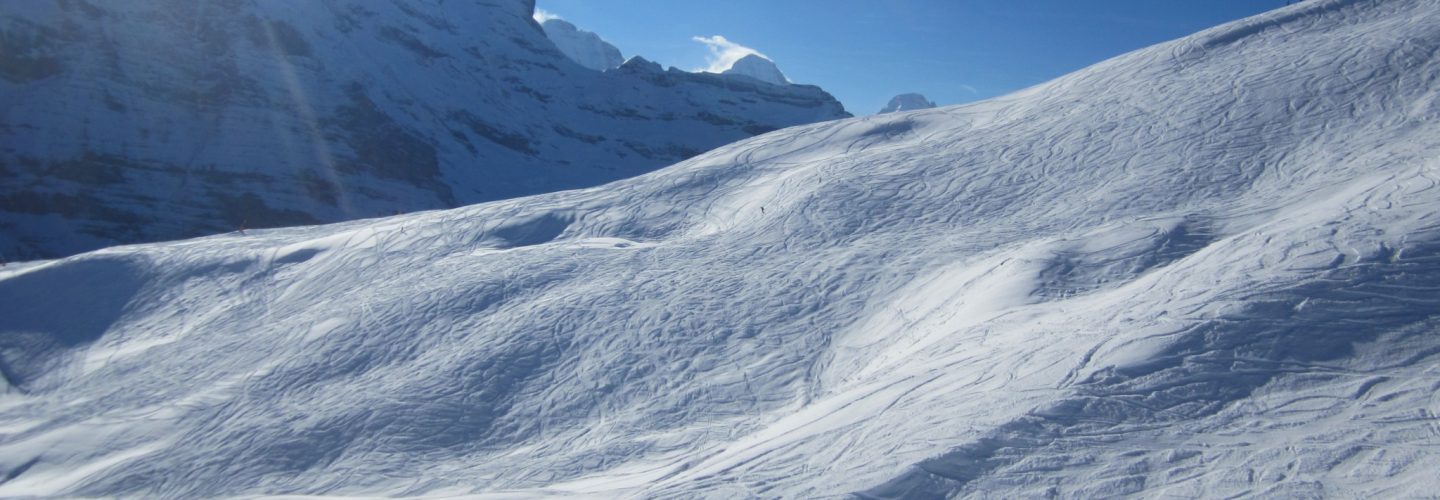There’s some debate about where downhill skiing began. St Moritz is currently celebrating 150 years since their first winter visitors, and it’s about the same time since the first type of downhill skiing was invented in Telemark, Norway. Then, around 130 years ago, the first Alpine ski descents were being made on long, thin skis carrying one long pole at resorts like Davos, and it was only 110 years ago that the modern style of alpine skiing we practise now began to be developed in Austria.
But one region perhaps has stronger and deeper roots in skiing history than any other. Switzerland’s Jungfrau, the stunning home of Grindelwald, Wengen and Mürren above the mountain town of Interlaken and below Europe’s highest rail-accessed point, the Jungfraujoch (3466m up), is where we Brits first discovered just how much fun skiing could be. People first started using the then new mountain railways as a means to get uphill before true ski lifts were invented, and the world-famous Downhill Only Club (DHO) established in Wengen is celebrating its 90th anniversary this year.
Few people who visit here don’t fall in love with it, and it’s easy to see why we’ve been returning season after season for much more than a century now.
The immediately impressive factor is the scenery, popularly regarded as some of the most spectacular in world skiing, particularly in Europe. The peaks of the Jungfrau, the Mönch and the Eiger, with majestic glaciers running down their sides, tower above the largely unspoilt mountain villages providing an awe-inspiring backdrop to your skiing every day.
Then there is, for want of a better word, the quaintness of it all. The three mountain resorts have changed little over the decades and are inter-connected by a narrow gauge cog railway system that’s been serving them for much more than a century now, day in, day out. The result is a truly timeless atmosphere, particularly in largely car-free Wengen. The ski lift pass is expensive (although children go half price) but it does include rail travel right down to the town of Interlaken in the valley below, as well as all the ski lifts, with trains running until late in the evening, so you are getting a lot of train and lift power for your investment.
Holders of passes valid three days or more can also take a day, or half day, off the slopes and enjoy a 50% discount on the additional cost of a lift ticket up to the Jungfraujoch, normally CHF60 return (approx. £45). Here there’s a Lindt chocolate shop, various viewing platforms and an ice cave system to explore inside the glacier included in your ticket cost. The trains up are overflowing with visitors from all around the world, all year long.
The main Jungfrau ski area adds up to over 200km of piste on the pass, which are world-class dimensions, but there are provisos. This is by no means a seamless giant ski area of wide, smooth pistes of the French purpose-built variety; it is a hotchpotch of runs and lifts that have developed through the last century, with winding pistes following the natural landscape eventually cajoled into meeting one another to create a linked-up area. Think central Rome rather than Las Vegas. In other words, it’s skiing history, and you may get a buzz from descending the very same slopes that those first skiers did 110 years ago or more.
But you will have to climb aboard an old train or walk to a cable car from most accommodations to get on to those slopes – doorstep skiing is hard to find, as in most classic resorts.
The largest of the three main segments, Kleine Scheidegg-Männlichen, is shared by Wengen and Grindelwald and perhaps equates to half the total available. There’s terrain for all standards right up to the route of the fearsome Lauberhorn, one of the ski racing world’s classic events staged each January, the week before the Hahnenkamm in Kitzbuhel. The longest and fastest of all the World Cup descents, in 2013 Johan Clarey of France hit 161.9 km/h (100.6 mph) on his descent, the first man to break the 100mph barrier in a downhill ski race. More than 30,000 spectators attend each year.
But here, and in the region’s other two main areas – across the valley on the Schilthorn at Murren and on the other side of Grindelwald in the first area – there’s terrain for all standards. Indeed an all-new separate beginners’ zone complete with covered conveyor lift opened at Kleine Scheidegg above Grindelwald and Wengen this winter.
The rail pass, the non-ski attractions like Interlaken, the Jungfraujoch options and the many non-ski activities available make the Jungfrau a great destination for mixed groups, with all age groups, all ability levels and most interests catered for on the snow or off.
There is little to choose between the resorts themselves. Grindelwald is the largest with the grandest hotels and the widest choice of dining and shopping, although these being traditional resorts many people stay on half-board accommodation anyway. Mürren and Wengen are small and intimate, and opinion has been divided between Brits for more than a century over which is marginally better. Mürren perhaps has the greater pedigree and has remained a favourite through the generations of British ski pioneers the Lunn family to this very day.
In these smaller resorts you can find traditional chalet accommodation and mostly 3★ and 4★ hotels that have changed little over the decades, so again you can feel the timelessness of the ski experience.
Whichever resort you choose, the most important thing before you start skiing is to sit still and look up, because the Jungfrau’s main asset is that this truly is one of the most spectacular locations on Earth.



